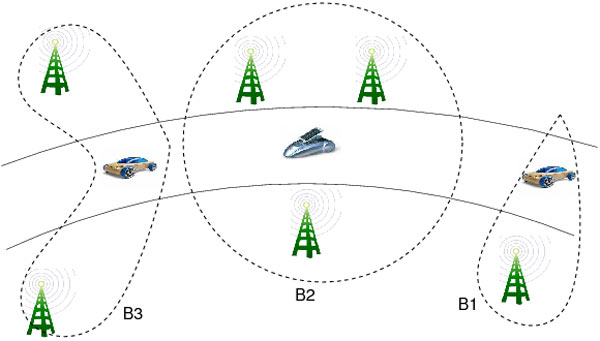Faster Internet on the Road
Researchers at Rutgers University’s Winlab and NEC Laboratories have developed a system that improves Internet access on the road. The system, called R2D2, uses special antennas and novel software to let users upload big chunks of information–like a video or a picture–over Wi-Fi significantly faster than other systems designed for use in vehicles.

Currently, a cell phone or computer accessing the Internet from a moving vehicle transmits to single base stations, even though the vehicle may move rapidly in and out of range. This can make Internet connections spotty, as anyone trying to access Wi-Fi on a bus knows.
The Rutgers researchers improved such connections by combining two existing techniques: directionality and diversity. Directionality involves focusing all of the radio energy from an antenna in a particular direction. This increases the average signal quality but can also cause the user to suddenly lose her Internet connection when the base tower is out of range. The other method, diversity, spreads out the antenna’s signal equally in all directions to encompass as many base towers as possible. This minimizes signal loss and fluctuations but weakens the signal. While most systems use one of these methods, R2D2 takes advantage of both.
“There’s an inherent paradox in using diversity and directionality,” says Ratul Mahajan, a Microsoft researcher who helped develop a vehicular Wi-Fi system (called ViFi) that uses diversity only. “R2D2 shows that it’s better to focus on the middle path between [these two techniques]. They did a good job of showing that this is one way to do it that is practical and brings significant gains.”
Kishore Ramachandran, a researcher at NEC Labs and lead author of the R2D2 work, will present it at the 2009 Mobile Systems, Applications and Services Conference in June. “You have to hit the sweet spot in between these two extremes,” he says. R2D2 calculates this balance between diversity and directionality, coordinates between multiple base stations, and maintains an optimizing database–all of which speed up data transfers.
“The nice thing about the proposed scheme is that it works well with existing Wi-Fi and vehicular radio standards,” says Dipankar Raychaudhuri, a researcher at Rutgers who was not involved in the work. The TR10 recipient adds that R2D2 could potentially “be really useful for emerging services involving cars on highways.”
When a user wants to, for example, upload a video to YouTube, information from the phone or laptop transmits to R2D2’s antenna, which sits on top of a vehicle. R2D2 relays that information to a group of Wi-Fi base stations through the fastest wireless path. The system also figures out how much to widen or narrow its antenna beam–it can warp the signal into multiple lobes, if needed–to reach the necessary base stations. To maintain its high signal quality, R2D2 continually switches base stations as the vehicle moves out of range.

Additional R2D2 software at the base stations coordinates between selected stations. R2D2 designates one station as the anchor, which routes the information to and from the Internet. The base station that gets the full packet of information first sends it to the anchor.
The researchers also created a software program that builds a database out of the best paths to use at different segments along a road, based on past use. This database, called the Beam Manager, divides a road into segments and assigns base-station groups to users depending on their location.
The group tested its system to see how much data R2D2 could transfer from a relay to a base station, compared with other new systems. The researchers did this by setting up four Wi-Fi base stations (using Linux device drivers) in a parking lot and along a street. To compare, they also tested a system called Mobisteer, which uses directionality to focus the antenna’s beam, and Microsoft’s ViFi, which uses diversity to transmit to several antennas at once. The researchers found that in about 200 seconds, R2D2 uploaded 216 megabytes of data while moving along at 15 to 20 miles per hour. That’s about 150 percent more than Mobisteer and about 40 percent more than ViFi.
Currently, most systems use cellular stations to access the Internet in vehicles. Before R2D2 and other Wi-Fi-based systems can be truly useful, cities and roads will need more Wi-Fi infrastructure as well.
Hannes Hartenstein, a professor at the University of Karlsruhe, in Germany, who has shown that diversity improved vehicle-to-vehicle communication, says that the R2D2 results look valid. He adds that the next step would be to see how this works for downloading data.
Keep Reading
Most Popular
Large language models can do jaw-dropping things. But nobody knows exactly why.
And that's a problem. Figuring it out is one of the biggest scientific puzzles of our time and a crucial step towards controlling more powerful future models.
The problem with plug-in hybrids? Their drivers.
Plug-in hybrids are often sold as a transition to EVs, but new data from Europe shows we’re still underestimating the emissions they produce.
Google DeepMind’s new generative model makes Super Mario–like games from scratch
Genie learns how to control games by watching hours and hours of video. It could help train next-gen robots too.
How scientists traced a mysterious covid case back to six toilets
When wastewater surveillance turns into a hunt for a single infected individual, the ethics get tricky.
Stay connected
Get the latest updates from
MIT Technology Review
Discover special offers, top stories, upcoming events, and more.